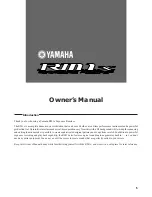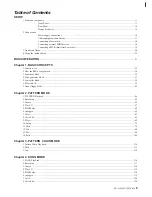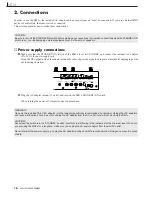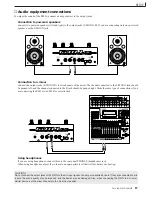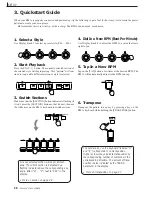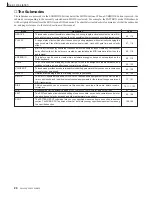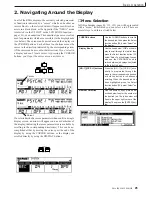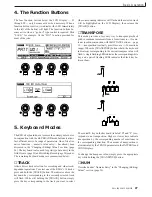
RM1x SEQUENCE REMIXER
13
Activates the record-ready mode in the RM1x PATTERN and SONG modes. The red REC
button indicator will light, then recording will begin as soon as the
p
button is pressed.
The
e
button can be pressed again to cancel the record-ready mode before recording
is actually started by pressing the
p
button.
Starts playback from the current point in the pattern or song if the record-ready mode is
not active, or recording from the same point if the record-ready mode is active. The green
PLAY indicator flashes at the current BPM during recording and playback.
Stops playback or recording.
Fast reverse and forward. Press the
r
or
f
button to rapidly move through the pattern
or song in the corresponding direction.
Top. Instantly returns to the first beginning of the current song or pattern (i.e. the first beat
of the first measure).
12. [EXIT] Button
The [EXIT] button takes you out of any function selected by the function buttons, or the edit or job modes (described
below), directly back to the current main mode (e.g. SONG or PATTERN).
13. Sequencer Buttons and Indicators
The sequencer buttons control recording and playback in the PATTERN, PATTERN CHAIN, and SONG modes.
REC
e
PLAY
p
STOP
s
r
&
f
t
SETUP
14. Keyboard
This 26-note keyboard makes it possible to program the RM1x without having to connect an external MIDI keyboard. It's
even polyphonic, so you can directly enter chords as well as single notes. The only thing it lacks is velocity sensitivity. The
RM1x does, however, accept velocity information from an external MIDI keyboard.
The keyboard also performs a range of functions as specified by the keyboard mode button (below): track selection,
transposition, numeric data entry, track mute/solo, and section selection. The “black keys” also perform a range of other
functions, such as selecting specific track ranges and memorizing a number of track mute setups.
15. Keyboard Mode Buttons
These buttons modify the function of the RM1x keyboard for track selection, transposition, numeric data entry, track mute/
solo, and section selection. Details are provided in the “Basic Operation” section beginning on page 23.
16. [OCT DOWN] and [OCT UP] Buttons
Although the range of the RM1x keyboard is a little over two octaves, the [OCT DOWN] and [OCT UP] buttons allow the
pitch of the keyboard to be shifted down or up in octave steps, over a range of 8 (+/- 4) octaves. Each time the [OCT
DOWN] button is pressed the pitch of the keyboard is shifted down by one octave, until the lower limit is reached. The
[OCT UP] button shifts the pitch of the keyboard up in the same way. The current amount of octave shift is indicated on the
LCD display.
17. [SHIFT] Button
The [SHIFT] button is used to access several secondary or “background” functions that you might only need in special
situations. For example, the [SHIFT] button can be used when you want to “solo” a track instead of muting it via the
[MUTE] keyboard mode button.
The [SHIFT] button can also be used in conjunction with the Display Knobs: hold the [SHIFT] button while rotating a knob
for faster data selection.
18. [ARPEGGIO ON] Button
Turns the RM1x's automatic arpeggio feature on or off (page 62). The [ARPEGGIO ON] button indicator will light when
the ARPEGGIO feature is on.
19. [TAP/ENTER] Button
This dual-purpose button is used both for tap-entry of BPM values (page 20), and to enter numeric values (page 26).





